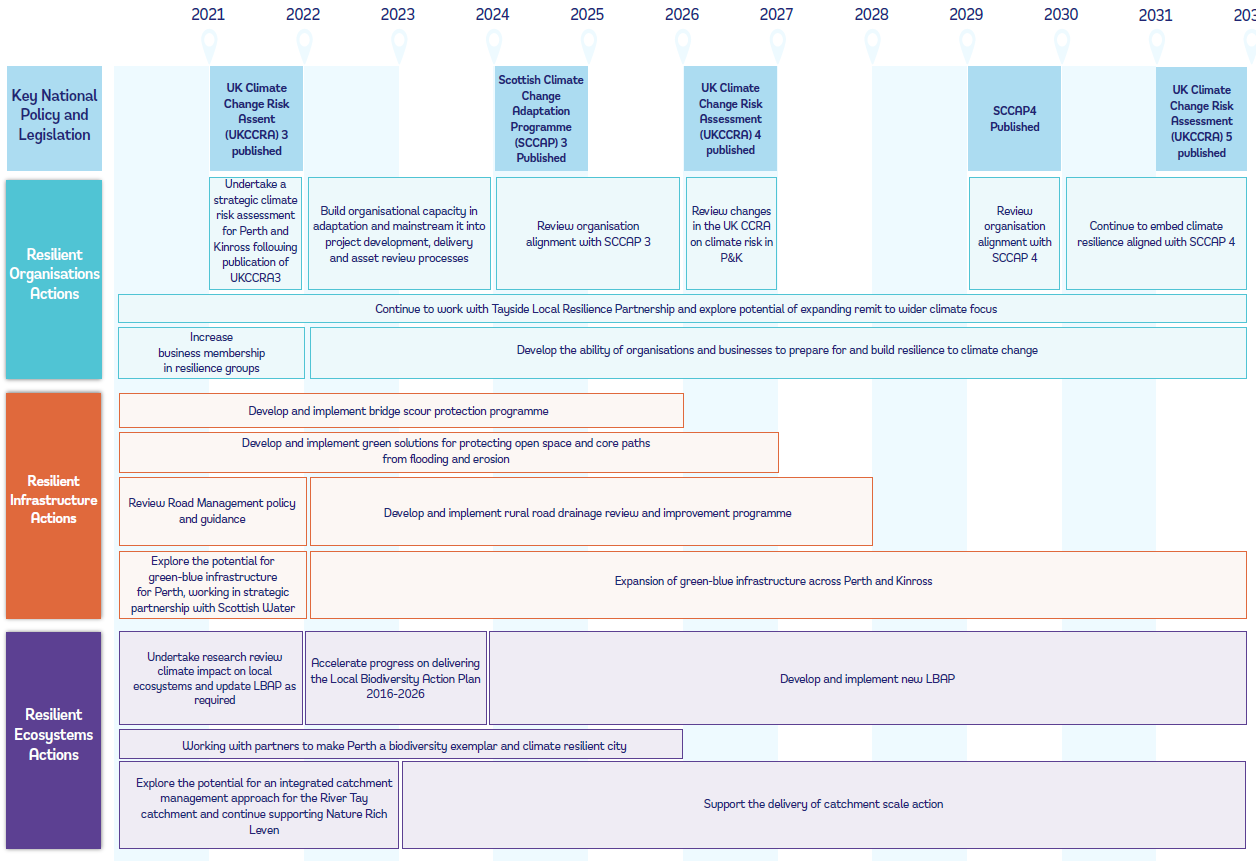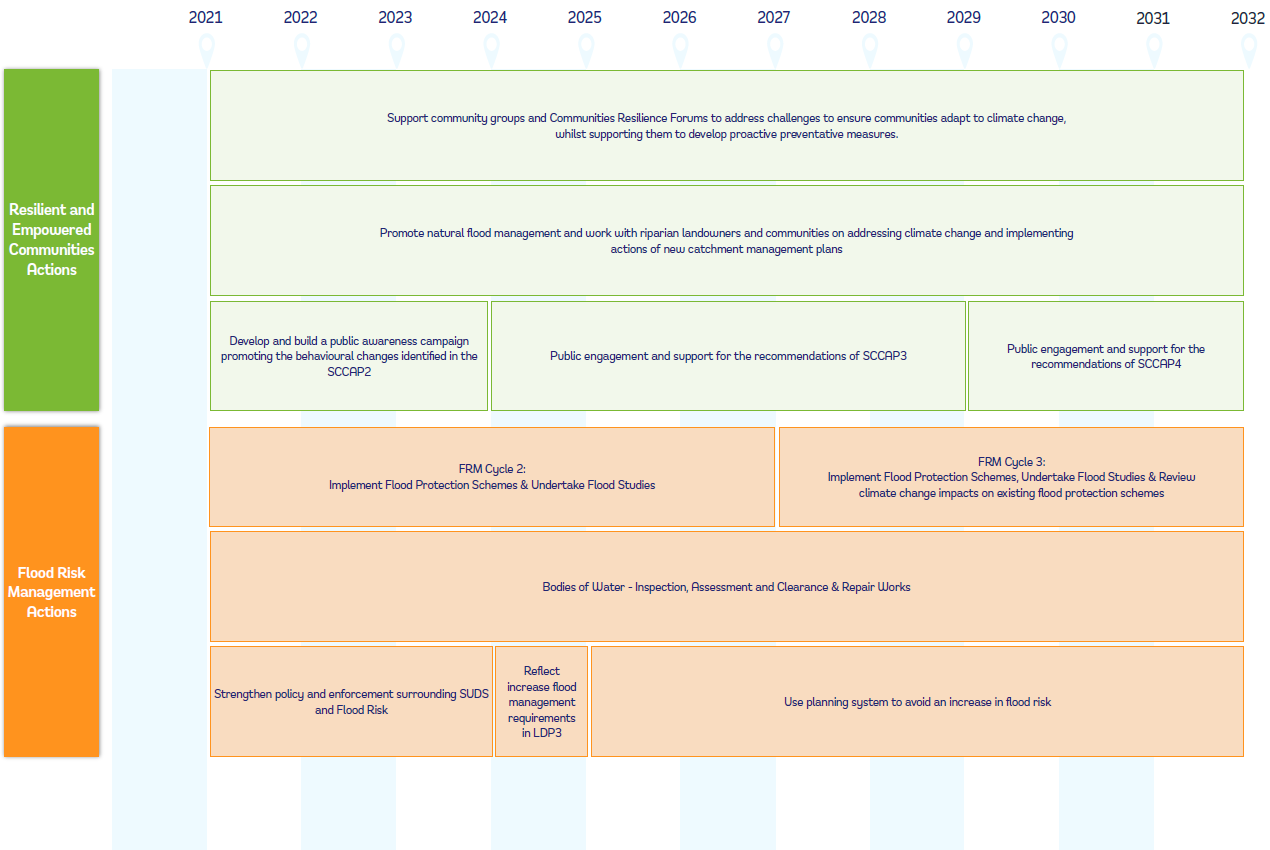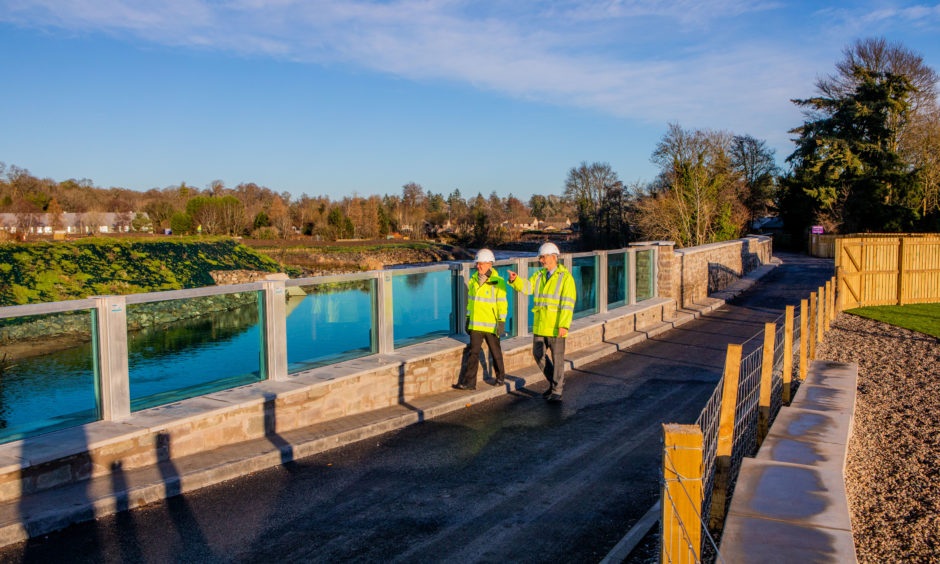Climate Resilience
Climate resilience relates to the ability to anticipate, prepare for, and respond to climate induced events – both acute events and longer-term trends. The impacts of climate change are already starting to be perceived across the Perth & Kinross Council area, with 91% of surveyed residents indicating that they are already noticing climatic changes.
In recent years, we have experienced increasing incidences of flash flooding in urban areas, as well as river flooding. Communities throughout Perth and Kinross including Perth, Comrie, Alyth, Aberfeldy, Almondbank, Kinross, Milnathort and Pitlochry have been affected. There have been landslips and closures of the rail line north and south of Perth due to flooding as well as increased scour on our bridges.
With climate change, it can be anticipated that there may be more chaotic and variable weather patterns, with the scale and frequency of partially dictated by how much future warming is limited over the coming two decades. Both the built and natural environment will be impacted.
As a Council, we have been working to improve resilience across Perth and Kinross. The most evident and frequent sign of extreme weather in Perth and Kinross is flooding, with several communities having experienced the devastating impact of flooding in recent years. In June 2016 we published our first local flood risk management plans setting out a range of actions it will be taking along with other responsible authorities to manage and, where achievable, reduce flood risk.
We work with our partners as part of the Tayside Local Resilience Partnership (Tayside LRP) to plan for and respond to emergencies. We also engage closely with many rural communities to support local resilience, which prepares them to be ready for extreme weather, flooding, power outages, or any other disruption to normal activities. Participation has reached its highest level - 24 community groups now have resilience plans in place, and tailored support has been provided to other groups to enhance their local capability.
The focus areas for the Resilience theme are:
Resilient organisations: Key actions include having an improved understanding of the risk, as well working to build organisational capacity and mainstream climate resilience into project development and delivery processes. Actions also include continued partnership support for the Tayside Local Resilience Partnership and helping businesses to prepare for, and build resilience to, climate change.
Resilient and empowered communities: Actions associated with this area are about empowering individuals and communities to take action to build resilience. Continuing to support and develop community resilience forums and other groups to develop proactive measures can have a significant impact, as will promoting natural flood management practices with riparian landowners and communities. More widely, it is necessary to develop an awareness raising campaign promoting the necessary behavioural changes identified in the SCCAP 2.
Resilient infrastructure: Actions focus on addressing several of the potential infrastructure vulnerabilities. These include undertaking bridge scour assessments and delivering the appropriate remedial works, as well as looking at rural road drainage. In our parks and open spaces, it will be necessary to develop green solutions to help manage the risks of flooding and erosion. More widely we need to examine how to maximise the planning and delivery of blue-green infrastructure in our towns and developments.
Flood risk management: Approximately 10% of homes and businesses in Perth and Kinross are now considered to be vulnerable to flooding, and this is likely to increase with climate change. Any actions which focus on managing flood risk are very important to residents and businesses. Actions focus on delivering the Perth & Kinross Council Flood Risk Management Plans which were published in 2016. A national public consultation on the second cycle of these Plans recently closed, and updated plans will be published by SEPA in December 2021 and by Perth & Kinross Council in 2022. Complementary to this, it is important that the Planning System is used to its capacity to avoid an increase in flood risk.
Resilient ecosystems: Linked with the flood risk management actions described above, is the proposal to develop an integrated catchment approach for the River Tay – this would look at several key areas: biodiversity enhancements, natural flood management, carbon sequestration and water quality enhancement. Perth & Kinross Council similarly needs to continue its contribution and support to the delivery of Nature Rich Leven and other catchment management approaches. More widely, it is important to update the Local Biodiversity Action Plan to reflect necessary adaptation measures to for our native flora and fauna and work with partners to make Perth a biodiversity exemplar and climate resilient city.
A climate emergency has been declared internationally and recognised by both the UK and Scottish Governments. The key long-term target is to ensure Perth & Kinross is net zero and climate resilient by 2045 at the latest. The following road map provides an overview of the actions which Perth & Kinross Council will undertake to build climate resilience.
There were several statutory requirements that were considered in the development of the Resilience Road Map. The main one is that under Section 44 of the Climate Change (Scotland) Act 2019, the Council must, in exercising its functions, act in the way best calculated to deliver any statutory adaptation programme. This statutory programme is updated every 5 years and is currently the Scottish Climate Change Adaptation Programme 2 (SCCAP2) 2019-2024.
There are two other key pieces of legislation. The Civil Contingencies Act (2004) identifies how climate resilience plays a significant role in identifying risks and reducing the impacts to be better prepared and more resilient to emergencies. The Flood Risk Management (Scotland) Act 2009 places various duties on Local Authorities, including the preparation of local flood risk management plans to target the areas of highest flood risk and ensure actions are locally targeted and delivered.
Climate resilience and adaption is mentioned in numerous other policies, strategies and legislation including:
- Scottish Planning Policy 2014
- Community Empowerment Act (2015)
- Planning etc. (Scotland) Act 2006 & 2019
- National Planning Framework 4 (2021)
- Building (Scotland) Regulations 2004
- Roads (Scotland) Act 1984
- Scottish Land Use Strategy 2016-2021
- Scottish Biodiversity Strategy
- Scottish Forestry Strategy
- Scotland’s Economic Strategy
- Scottish Soil Framework
- Marine (Scotland) Act 2010
- Water-resilient places (2021)
The scale of the impact of delivering the roadmap is hard to quantify due to the uncertainty around if, and when, climatic events will occur. In general, each £1 spent on resilience measures has been demonstrated to generate between £2-£10 pounds in savings. The benefits of the actions include a reduced risk of disruption to infrastructure, improved economic and social resilience, improved flood risk management, healthier ecosystems, and improved water quality.


The following key challenges and opportunities have been identified during the development of the Climate Action Plan:
- When are you resilient: One of the biggest challenges for resilience action is knowing when a state of resilience has been reached. This can make it hard to generate a shared vision and impetus for action although, as demonstrated by recent events, this is required. It is important to raise awareness among the public of the risks and required actions.
- Behavioural shifts: Improving resilience will require a behavioural shift from reactive to proactive measures by residents and businesses, as well as Perth & Kinross. For example, the primary responsibility for avoiding or managing flood risk rests with land and property owners. While Perth & Kinross Council plays an important proactive role in flood risk management, it cannot do this alone and needs residents and businesses to make themselves and their properties more resilient to reduce the impact of flooding.
- Wider interlinkages: Resilience needs to be wider than just climate change – if systems are unhealthy or at breaking point, a minor climate disturbance can cause serious damage. This also means that improving climate resilience also provides the opportunity to build resilience to non-climate related disturbances.
- Links with mitigation: Resilience is interlinked with climate mitigation – many of the actions to reduce emissions also improve resilience, such as peatland restoration both sequesters carbon and can help reduce peak flood flows.
Please see our Take Action and Get Involved pages to help towards tackling climate change.
The following Key Performance Indicators have been developed to enable progress and monitor climate action related to Resilience. The KPI framework will be further developed during 2022.
| Key Theme | Performance Indicator | Baseline Value |
| Resilient organisations | Annual Scotland Adapts Capability Framework score | Indicator methodology and baseline under development – to be finalised in 2022 |
| Resilient and empowered communities | Number of community groups engaged in proactive climate resilience work | Indicator methodology and baseline under development – to be finalised in 2022 |
| Resilient infrastructure | Number of Sustainable Urban Drainage Systems Introduced | Indicator methodology and baseline under development – to be finalised in 2022 |
| Flood risk management | Number of homes and businesses identified as at flood risk | Indicator methodology and baseline under development – to be finalised in 2022 |
Adaptation Scotland: https://www.adaptationscotland.org.uk/
The Scottish Climate Change Adaptation Programme 2019-2024: https://www.gov.scot/publications/climate-ready-scotland-second-scottish-climate-change-adaptation-programme-2019-2024/
Climate Projections for Scotland: https://public-assets-02.everywhere.davidsonandrobertson.co.uk/download_file/view/950/163
UK Climate Change Risk Assessment: https://www.theccc.org.uk/uk-climate-change-risk-assessment-2017/
Scotland’s climate is already changing. Over the last century temperatures have increased, sea levels have risen, and rainfall patterns have changed, with increased seasonality and more heavy downpours. Specifically, within Perth and Kinross, there have been increasing incidences of both flash flooding in urban areas and river flooding. This has caused damage to properties and assets as well as causing landslips and scour to bridges. These changes are projected to continue and intensify over the coming decades, and we can expect future changes in climate to be far greater than anything we have seen in the past. In support of Perth & Kinross Council's Climate Action Plan, the Council commissioned Arup to develop our first Climate Risk and Opportunity Assessment (CCROA). Climate risk assessments identify the likelihood of future climate hazards and their potential impacts for cities and their communities. This information is fundamental for informing the prioritisation of climate action, investment in adaptation and supporting community resilience groups.
An executive summary can be found at Perth and Kinross Climate Change Risk and Opportunities Assessment Executive Summary while the full Report can be accessed at Perth and Kinross Climate Change Risk and Opportunities Assessment
We have developed a storymap that presents data from the report using interactive maps to inform communities of the projected changes, local impacts and associated risks. The data can help provide an evidence base for the preparation of community-led plans and projects. The storymap can be accessed at Perth and Kinross Climate Change Projections.
A vulnerability map has also been developed to show how climate hazards will impact communities while highlighting vulnerable population demographics and can be found at Climate Hazard Exposure and Population Vulnerability. For any questions please contact [email protected]
Case Studies
Adapting to Climate Change in the Carse of Gowrie Communities
Adapting to Climate Change in the Carse of Gowrie Communities will benefit from having a more direct stake in their environment and become more resilient to the climate changes happening around them, both locally and globally. Working in partnership, Perth & Kinross Council, Adaptation Scotland, SNIFFER and Carse of Gowrie's Sustainability Group, helped the community to map their local area to consider the likely impacts and effects of climate change – and the potential to proactively adapt to address the challenges and issues that this might bring. The community went on to develop a resilience plan for the area.
Flood Protection Schemes
Perth & Kinross Council has adopted a new national approach to manage the increasing risk of flooding due to climate change. To better plan and co-ordinate action on flooding, Perth & Kinross Council is working closely with SEPA, Scottish Water, other local authorities, Scottish Forestry and the national parks to implement new national and local plans. First published in 2015 and 2016, these documents set out how flooding is being tackled now and in the future and how we will reduce the impact of our unpredictable weather. The required process of flood risk assessment, flood mapping and planning is being repeated every six years with the long-term goal of reducing flood risk across Scotland over time. In combination with increasing education and awareness within communities about how they can protect themselves from flooding, the range actions set out in the plans are aimed at managing and, where achievable, reducing the overall risk of flooding to residents and businesses.
Perth & Kinross Council is engaged in implementing the actions set out in the plans and will continue to record and investigate flood events, inspect and clear bodies of water and progress flood protection works and schemes in areas where there is a known flood risk. Flood protection schemes have already been implemented in Perth, Comrie, Weem, Bridge of Earn and Milnathort and a new scheme at Almondbank has recently been completed. Perth & Kinross Council is currently developing proposals for new flood protection schemes in Comrie, Milnathort, Kinross and Scone. Following recent flood studies, further flood protection schemes have been identified in Pitlochry, Aberfeldy and Blackford. Flood studies are on-going in Invergowrie, Dunkeld, Perth and Alyth with other areas (including Scone and Blairgowrie) to follow. Read more about our flood protection work.
Perth & Kinross Council promotes flood resilience within communities and the use of property flood protection products by private householders and businesses. Information for residents and businesses is available on the Perth & Kinross Council flooding webpages, as well as, by contacting the Perth and Kinross Council Flooding Team or the Scottish Flood Forum who can provide general advice on flood protection products upon request.

Contact Information
[email protected] (General)
[email protected] (Flooding)
[email protected]
(Emergency planning advise)


